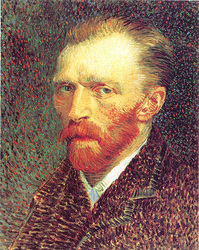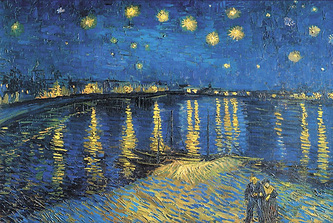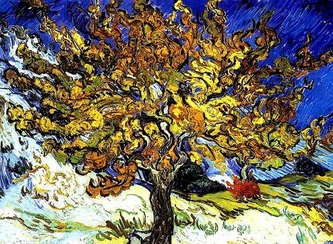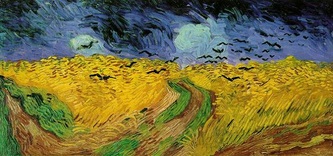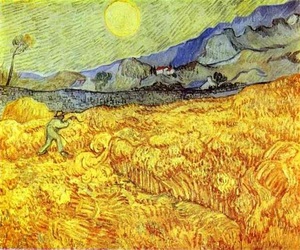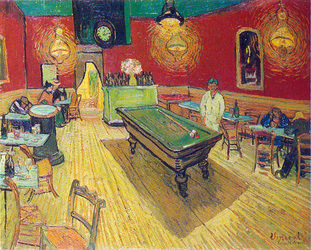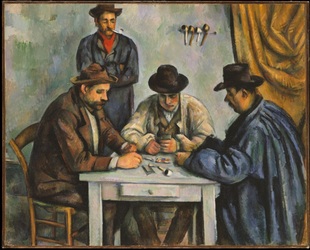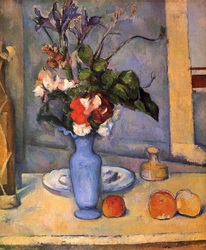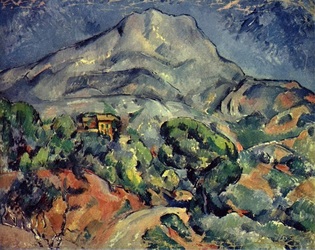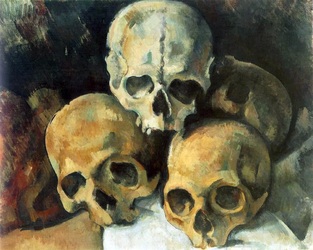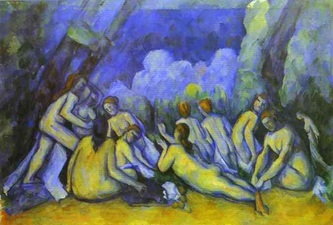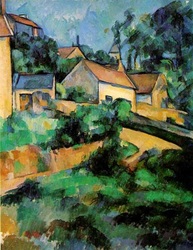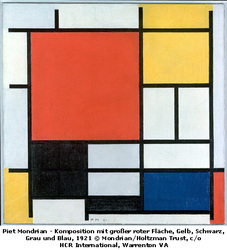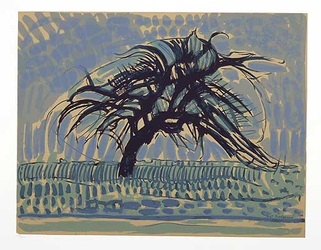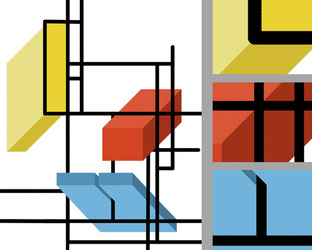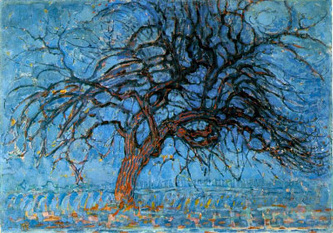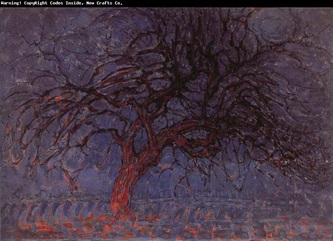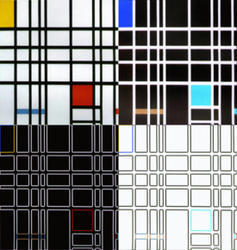Vincent Van Gogh
Vincent van Gogh was born in Groot Zundert, The Netherlands on 30 March 1853. Van Gogh's birth came one year to the day after his mother gave birth to a first, stillborn child--also named Vincent. There has been much speculation about Vincent van Gogh suffering later psychological trauma as a result of being a "replacement child" and having a deceased brother with the same name and same birth date. This theory remains unsubstantiated, however, and there is no actual historical evidence to support it.
Van Gogh was the son of Theodorus van Gogh (1822-85), a pastor of the Dutch Reformed Church, and Anna Cornelia Carbentus (1819-1907). Unfortunately there is virtually no information about Vincent van Gogh's first ten years. Van Gogh attended a boarding school in Zevenbergen for two years and then went on to attend the King Willem II secondary school in Tilburg for two more. At that time, in 1868, Van Gogh left his studies at the age of 15 and never returned.
Vincent was relatively successful as an art dealer and stayed with Goupil & Cie. for seven more years. In 1873 he was transferred to the London branch of the company and quickly became enamoured with the cultural climate of England. In late August, Vincent moved to 87 Hackford Road and boarded with Ursula Loyer and her daughter Eugenie. Vincent is said to have been romantically interested in Eugenie, but many early biographers mistakenly misname Eugenie for her mother, Ursula. To add to the decades-long confusion over the names, recent evidence suggests that Vincent wasn't in love with Eugenie at all, but rather a Dutch woman named Caroline Haanebeek. The truth remains inconclusive.
In autumn of 1880, after more than a year living as a pauper in the Borinage, Vincent left for Brussels to begin his art studies. Vincent was inspired to begin these studies as a result of financial help from his brother, Theo. Vincent and Theo had always been close as children and throughout most of their adult lives maintained an ongoing and poignantly revealing correspondence. It is these letters, in total more than 700 extant, which form most of our knowledge of Van Gogh's perceptions about his own life and works. 1881 would prove to be a turbulent year for Vincent van Gogh. Vincent applied for study at the Ecole des Beaux-Art in Brussels, although the biographers Hulsker and Tralbaut conflict with regards to the details. Tralbaut suggests a short and unremarkable tenure with the school, whereas Hulsker maintains that Vincent's application for admission was never accepted. Whatever the case, Vincent continued drawings lessons on his own, taking examples from such books as Travaux des champs by Jean-François Millet and Cours de dessin by Charles Bargue. In the summer Vincent was once again living with his parents, now situated in Etten, and during that time he met his cousin Cornelia Adriana Vos-Stricker (Kee). Kee (1846-1918) had been recently widowed and was raising a young son on her own. Vincent fell in love with Kee and was devastated when she rejected his advances. The unfortunate episode concluded with one of the most memorable incidents in Van Gogh's life. After being spurned by Kee, Vincent decided to confront her at her parents house. Kee's father refused to let Vincent see his daughter and Vincent, ever determined, put his hand over the funnel of an oil lamp, intentionally burning himself. Vincent's intent was to hold his hand over the flame until he was allowed to see Kee. Kee's father quickly defused the situation by simply blowing out the lamp and Vincent left the house humiliated. Despite emotional setbacks with Kee and personal tensions with his father, Vincent found some encouragement from Anton Mauve (1838-88), his cousin by marriage. Mauve had established himself as a successful artist, and from his home in The Hague, supplied Vincent with his first set of watercolours--thus giving Vincent his initial introduction to working in colours. Vincent was a great admirer of Mauve's works and was deeply grateful for any instruction that Mauve was able to provide. Their relationship was a pleasant one, but would suffer due to tensions brought about when Vincent began living with a prostitute.
Van Gogh was the son of Theodorus van Gogh (1822-85), a pastor of the Dutch Reformed Church, and Anna Cornelia Carbentus (1819-1907). Unfortunately there is virtually no information about Vincent van Gogh's first ten years. Van Gogh attended a boarding school in Zevenbergen for two years and then went on to attend the King Willem II secondary school in Tilburg for two more. At that time, in 1868, Van Gogh left his studies at the age of 15 and never returned.
Vincent was relatively successful as an art dealer and stayed with Goupil & Cie. for seven more years. In 1873 he was transferred to the London branch of the company and quickly became enamoured with the cultural climate of England. In late August, Vincent moved to 87 Hackford Road and boarded with Ursula Loyer and her daughter Eugenie. Vincent is said to have been romantically interested in Eugenie, but many early biographers mistakenly misname Eugenie for her mother, Ursula. To add to the decades-long confusion over the names, recent evidence suggests that Vincent wasn't in love with Eugenie at all, but rather a Dutch woman named Caroline Haanebeek. The truth remains inconclusive.
In autumn of 1880, after more than a year living as a pauper in the Borinage, Vincent left for Brussels to begin his art studies. Vincent was inspired to begin these studies as a result of financial help from his brother, Theo. Vincent and Theo had always been close as children and throughout most of their adult lives maintained an ongoing and poignantly revealing correspondence. It is these letters, in total more than 700 extant, which form most of our knowledge of Van Gogh's perceptions about his own life and works. 1881 would prove to be a turbulent year for Vincent van Gogh. Vincent applied for study at the Ecole des Beaux-Art in Brussels, although the biographers Hulsker and Tralbaut conflict with regards to the details. Tralbaut suggests a short and unremarkable tenure with the school, whereas Hulsker maintains that Vincent's application for admission was never accepted. Whatever the case, Vincent continued drawings lessons on his own, taking examples from such books as Travaux des champs by Jean-François Millet and Cours de dessin by Charles Bargue. In the summer Vincent was once again living with his parents, now situated in Etten, and during that time he met his cousin Cornelia Adriana Vos-Stricker (Kee). Kee (1846-1918) had been recently widowed and was raising a young son on her own. Vincent fell in love with Kee and was devastated when she rejected his advances. The unfortunate episode concluded with one of the most memorable incidents in Van Gogh's life. After being spurned by Kee, Vincent decided to confront her at her parents house. Kee's father refused to let Vincent see his daughter and Vincent, ever determined, put his hand over the funnel of an oil lamp, intentionally burning himself. Vincent's intent was to hold his hand over the flame until he was allowed to see Kee. Kee's father quickly defused the situation by simply blowing out the lamp and Vincent left the house humiliated. Despite emotional setbacks with Kee and personal tensions with his father, Vincent found some encouragement from Anton Mauve (1838-88), his cousin by marriage. Mauve had established himself as a successful artist, and from his home in The Hague, supplied Vincent with his first set of watercolours--thus giving Vincent his initial introduction to working in colours. Vincent was a great admirer of Mauve's works and was deeply grateful for any instruction that Mauve was able to provide. Their relationship was a pleasant one, but would suffer due to tensions brought about when Vincent began living with a prostitute.
Paul Cezanne
Cézanne was born in the southern French town of Aix-en-Provence, January 19, 1839, the son of a wealthy banker. His boyhood companion was émile Zola, who later gained fame as a novelist and man of letters. As did Zola, Cézanne developed artistic interests at an early age, much to the dismay of his father. In 1862, after a number of bitter family disputes, the aspiring artist was given a small allowance and sent to study art in Paris, where Zola had already gone. From the start he was drawn to the more radical elements of the Parisian art world. He especially admired the romantic painter Eugène Delacroix and, among the younger masters, Gustave Courbet and the notorious Edouard Manet, who exhibited realist paintings that were shocking in both style and subject matter to most of their contemporaries.
Many of Cézanne's early works were painted in dark tones applied with heavy, fluid pigment, suggesting the moody, romantic expressionism of previous generations. Just as Zola pursued his interest in the realist novel, however, Cézanne also gradually developed a commitment to the representation of contemporary life, painting the world he observed without concern for thematic idealization or stylistic affectation.
The most significant influence on the work of his early maturity proved to be Camille Pissarro, an older but as yet unrecognized painter who lived with his large family in a rural area outside Paris. Pissarro not only provided the moral encouragement that the insecure Cézanne required, but he also introduced him to the new impressionist technique for rendering outdoor light.
Many of Cézanne's early works were painted in dark tones applied with heavy, fluid pigment, suggesting the moody, romantic expressionism of previous generations. Just as Zola pursued his interest in the realist novel, however, Cézanne also gradually developed a commitment to the representation of contemporary life, painting the world he observed without concern for thematic idealization or stylistic affectation.
The most significant influence on the work of his early maturity proved to be Camille Pissarro, an older but as yet unrecognized painter who lived with his large family in a rural area outside Paris. Pissarro not only provided the moral encouragement that the insecure Cézanne required, but he also introduced him to the new impressionist technique for rendering outdoor light.
Piet Mondarion
MONDRIAN'S YOUTH
Born as Pieter Cornelis Mondriaan Jr. in Amersfoort (The Netherlands) on March 7, 1872, his future lay in teaching. Piet Mondrian's father, who was also a teacher, wished that his son with follow in his footsteps. Piet Mondrian earned his diploma in teaching but decided In 1892 to enter the Academy of Fine Arts in Amsterdam.
MONDRIAN'S FIRST YEARS AS AN ARTIST
Piet Mondrian was heavily influenced by what he learned at the Academy of Fine Arts. Mondrian's first works were classical landscape and still-life impressionistic paintings. In 1909 and 1910 Mondrian experimented with symbolism and cubism. It was after visiting an exhibition of Braque and Picasso (the two founders of Cubism) that Mondrian decided to move to Paris, the heart of visual arts.
Soon after his arrival in Paris, Mondrian reached international fame with exhibitions in Paris and Berlin. Mondrian didn't make a living by selling his own work, but instead he sold works he copied at The Louvre. In Paris he first started developing his own abstract style.
THE STYLE
In 1914 when World War I began, Mondrian was visiting his home country and was unable to return to Paris. During the war years, Mondrian continued reducing the geometrical shapes and colors in his paintings which defined his neo-plasticism, also known as The Style (De Stijl). This movement which included Theo van Doesburg, Bart van der Leck, and Georges Vantongerloo, extended its principles of abstraction and simplification beyond painting and sculpture to architecture and graphic and industrial design. Their newly founded magazine 'De Stijl' contained several essays on abstract art of Mondrian. In July 1919 Mondrian returned to Paris, where he decided to withdraw from The Style when the artist van Doesburg introduced diagonal elements into his work.
MONDRIAN IN LONDON AND NEW YORK
When Hitler called Mondrian's work degenerate art, Mondrian decided to leave Paris before the German invasion. In 1938 Mondrian decided to live in London where he met fellow artists such as Barbara Hepworth and Ben Nicholson. As the Germans increased pressure on the UK, Mondrian left for New York were he arrived in October 1940. In New York Mondrian concluded his career with monumental works like "Broadway Boogie-Woogie" and (the unfinished) "Victory Boogie-Woogie". February 1, 1944 (at the age of 71) Piet Mondrian died of pneumonia in a New York hospital.
Born as Pieter Cornelis Mondriaan Jr. in Amersfoort (The Netherlands) on March 7, 1872, his future lay in teaching. Piet Mondrian's father, who was also a teacher, wished that his son with follow in his footsteps. Piet Mondrian earned his diploma in teaching but decided In 1892 to enter the Academy of Fine Arts in Amsterdam.
MONDRIAN'S FIRST YEARS AS AN ARTIST
Piet Mondrian was heavily influenced by what he learned at the Academy of Fine Arts. Mondrian's first works were classical landscape and still-life impressionistic paintings. In 1909 and 1910 Mondrian experimented with symbolism and cubism. It was after visiting an exhibition of Braque and Picasso (the two founders of Cubism) that Mondrian decided to move to Paris, the heart of visual arts.
Soon after his arrival in Paris, Mondrian reached international fame with exhibitions in Paris and Berlin. Mondrian didn't make a living by selling his own work, but instead he sold works he copied at The Louvre. In Paris he first started developing his own abstract style.
THE STYLE
In 1914 when World War I began, Mondrian was visiting his home country and was unable to return to Paris. During the war years, Mondrian continued reducing the geometrical shapes and colors in his paintings which defined his neo-plasticism, also known as The Style (De Stijl). This movement which included Theo van Doesburg, Bart van der Leck, and Georges Vantongerloo, extended its principles of abstraction and simplification beyond painting and sculpture to architecture and graphic and industrial design. Their newly founded magazine 'De Stijl' contained several essays on abstract art of Mondrian. In July 1919 Mondrian returned to Paris, where he decided to withdraw from The Style when the artist van Doesburg introduced diagonal elements into his work.
MONDRIAN IN LONDON AND NEW YORK
When Hitler called Mondrian's work degenerate art, Mondrian decided to leave Paris before the German invasion. In 1938 Mondrian decided to live in London where he met fellow artists such as Barbara Hepworth and Ben Nicholson. As the Germans increased pressure on the UK, Mondrian left for New York were he arrived in October 1940. In New York Mondrian concluded his career with monumental works like "Broadway Boogie-Woogie" and (the unfinished) "Victory Boogie-Woogie". February 1, 1944 (at the age of 71) Piet Mondrian died of pneumonia in a New York hospital.
Picasso
Pablo Ruiz Picasso was born on the 25th October, 1881 in Malaga in Spain. Picasso's father was a painter and a professor of art at the School of Crafts and the curator of a local museum. Picasso learnt the basics of art from his father. Picasso also attended the Academy of Arts in Madrid, but dropped out within a year of joining it. In 1901, Picasso started a magazine called ‘Arte Joven’ in Madrid with his friend Soler. He completely illustrated the first edition of the magazine. It was at this point that he began to sign his paintings as simply ‘Picasso’ rather than ‘Pablo Ruiz y Picasso’. All the paintings by Pablo Picasso are usually classified into various ‘periods’ based on the moods and styles of the paintings. These, in turn, were largely affected by his personal and love life. His real work and career as a painter is said to begin around 1894 with a painting called ‘The First Communion’ which showed his sister Lola. Eighteen ninty nine to 1900 was a period where Picasso was creating paintings in a Modernist style which emerged due to his influence and exposure to the works of Rossetti, Edward Munch etc. From 1901 to 1904 is called Picasso’s Blue Period because many of his paintings in that time were in the shades of blue and blue-green. The subjects of these paintings were prostitutes and beggars. From 1905 to 1907 is called Picasso’s Rose Period where his paintings became cheerful with the use of orange and pink colors. 1907 to 1909 is called his African Influenced Period where his drawings were inspired by African artifacts. A good example of this period is his painting titled ‘Les Demoiselles d’Avignon’. 1909 to 1912 is called Picasso’s Analytic Cubism Period. 1912 to 1919 is called Picasso’s Synthetic Cubism Period where he began to use collage in his art. He would add paper fragments of wallpaper or newspaper pages and paste them into his work.
